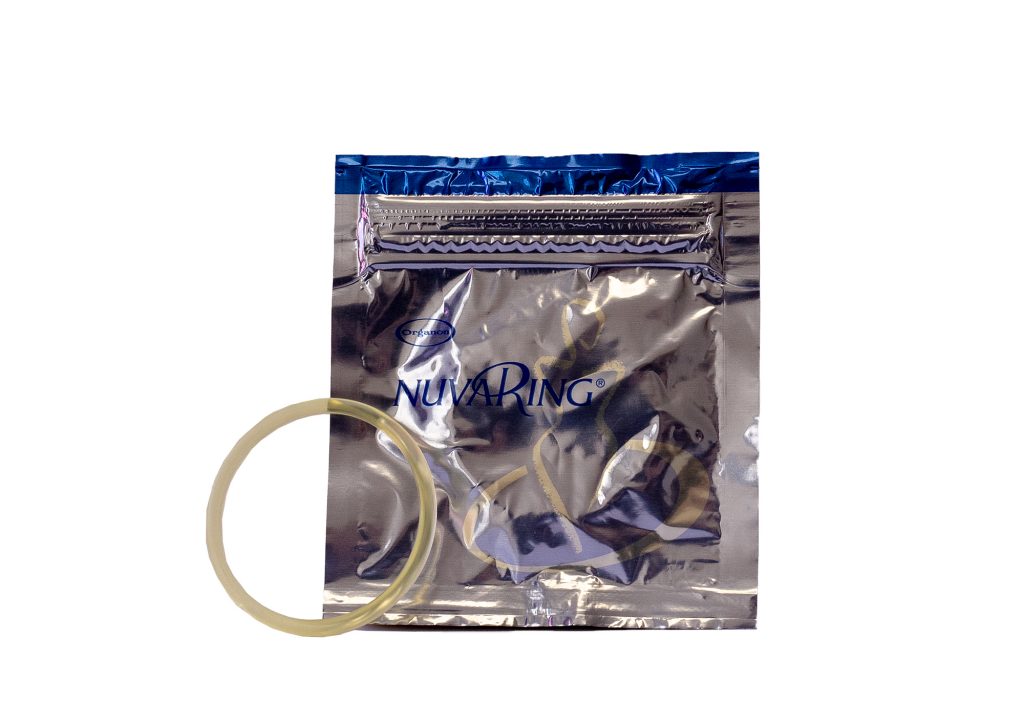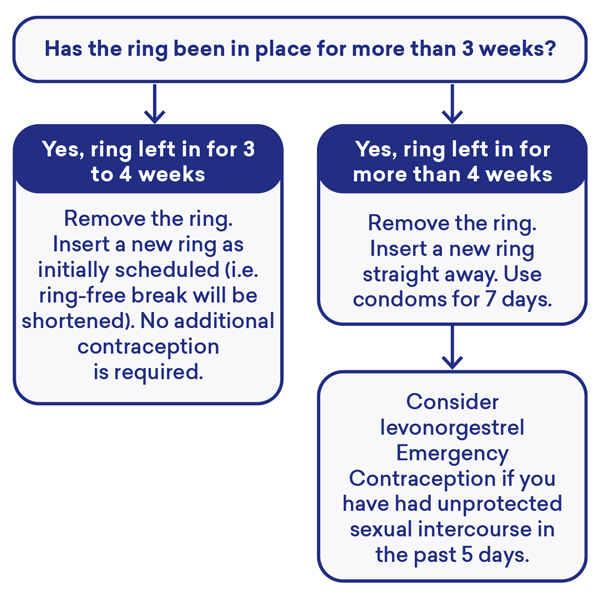What is the vaginal ring?
It is a soft plastic ring that you place into the vagina once a month. It is left in place for 3 weeks and taken out for 1 week. Once inserted the ring slowly releases two artificial hormones, oestrogen and progestogen – these are similar to hormones naturally produced by the body. The hormones are the same as those used in the Pill, but are absorbed through the vagina, not the stomach. The vaginal ring is used to prevent pregnancy or to control periods.
There is one brand currently available in Australia, called NuvaRing.

How does the ring work?
The ring works by:
- stopping the release of an egg by the ovary (ovulation)
- making the mucus (sticky fluid) at the opening of the uterus thicker so sperm can’t get through
How effective is it?
The ring is greater than 99% effective with perfect use, but with typical day-to-day use it is about 93% effective.
How do I get the ring?
The ring is available on prescription, which can be obtained from your doctor, SHINE SA clinics, community health clinics or youth health clinics.
How do I use the ring?
- To insert the ring squeeze it between your thumb and index finger, and then gently insert it into your vagina. Remember, the exact position is not important for the ring to work. If you feel discomfort simply slide it further into your vagina. Your vaginal muscles will keep the ring securely in place, even during sex and exercise. Anyone who is able to insert a tampon should be able to insert the ring.
- To remove the ring simply put your finger into your vagina, hook it inside the rim of the ring and pull it out.
- You can begin using the ring anytime within the first 5 days of your period starting, so that pregnancy protection is immediate. If you insert it more than 5 days after your period started, you will need to use other forms of contraception for 7 days.
- After insertion, the ring is left in place for 3 weeks, then removed and a new ring inserted a week later. A bleed may occur in the week when the ring has been removed. It is important to put in a new ring no more than 7 days after removal of the previous one, even if you have not stopped bleeding.
- It is important to store and use the ring according to the manufacturer’s instructions. It needs to be kept cool and only lasts for 4 months after you get it from the pharmacy.
Can I skip my period?
It is possible to skip the 7 ring-free days and replace a new ring immediately after taking the old one out so that you should not get a bleed. It is safe to do this although some people may experience breakthrough bleeding. Once it is in the vagina the next 3 weeks of use has started.
When is the ring not effective?
The ring may not be effective if:
- you have forgotten to insert a ring for the next cycle (more than 7 days since your last ring was removed)
- your ring has been removed from the vagina for more than 24 hours
- your ring has been left in place continuously for more than 4 weeks
Always check with your doctor or contact SHINE SA’s Sexual Healthline if you are taking other medications, as some drugs may stop the ring from working (e.g. some anti-epileptic medication). This can also include herbal medicines like St John’s Wort. If you are taking one of these medications you will need to use other protection while taking the medication and for one month after stopping.
What are the benefits of using the ring?
- Periods become more regular, shorter, lighter and less painful.
- The timing of bleeding can be controlled.
- The hormones are absorbed directly into the bloodstream. They don’t go through the stomach and so are not affected by vomiting or diarrhoea.
- You don’t have to remember to take a pill every day.
- It can be used as a treatment for menstrual abnormalities.
- It’s easily reversible and has no effect on future fertility.
What are the possible side effects?
The ring has few side effects. Serious health problems caused by the ring are rare; the most dangerous is blood clots, usually in the legs or lungs (called thrombosis).
You may notice:
- irregular bleeding
- headaches (more than normal)
- an increase in appetite
- sore breasts (supportive bra can help)
- changes in mood, including feeling depressed
Most of these side effects will settle within 2–3 months of using the ring. If they persist discuss them with your doctor.
Who should not use the ring?
The ring is safe for most people. In particular, the risks of using the ring are less than the risks of being pregnant.
The ring is not suitable for someone who:
- has had a stroke, heart attack or high blood pressure
- as a past or close family history of blood clots
- has certain types of migraine, diabetes or liver disease
- is over 35 years and smokes
- has a body mass index >35
It may not be suitable for people who are breastfeeding or have chronic constipation or vaginal prolapse.
What if the ring accidentally comes out of the vagina?
The ring should be left in the vagina for 3 weeks. If the ring is accidentally expelled, it can be rinsed with water and should be put back in immediately.
What if the ring is late?

If you are worried your ring is late, contact a pharmacist, doctor or SHINE SA clinic.
If you are thinking about using Emergency Contraception (EC), it’s best taken as soon as possible, but can be taken up to 5 days after unprotected sex. The most effective EC is a copper IUD. There are 2 different Emergency Contraceptive Pills (ECP) available in Australia and your doctor or pharmacist can advise you which is the best one for you. For more information on EC see SHINE SA’s Fact Sheet.
The ring does not protect against sexually transmitted infections (STIs) or blood-borne viruses (BBVs). Practise safer sex. Condoms reduce the risk of STIs and BBVs.






